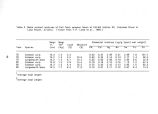| OCR Text |
Show Table 6. Suggested surface- water- quality monitoring program for streams, springs, and seeps located in the vicinity of tar sands development. ( Adapted from Flug, 1985, and State of Colorado, 1982.) Field measurements discharge specific conductance dissolved oxygen 2 Chemical constituents pH water temperature total suspended solids total dissolved solids oil and grease dissolved organic carbon . iDOC) DOC analysis by fraction alkalinity sodium calcium Suggested metals package 2,5 chloride magnesium total nitrogen . nitrogen composition total phosphorus sulfate boron fluoride aluminum arsenic cadmium copper ironc lead6 manganese molybdenum mercury selenium zinc Frequency 1. Perennial streams a. Measure field water quality parameters monthly. b. Sample water for complete chemical analysis quarterly, especially during high and low flow periods. Record flow at time of sampling. c. Install a continuous recording device to monitor flow. Report monthly minimum, maximum, and mean flows. 2. Intermittent streams a. Sample frequency will be figured on an individual basis. The Water Resource Division will be consulted before initiating baseline studies. Record flow at time of sampling. b. Determine duration of flow season and seasonal peak flow. 3. Springs and seeps a. Measure field water- quality parameters monthly ( pH, specific conductance, and temperature). Record flow at time of sampling. b. Sample water for complete chemical analysis quarterly. Record flow at time of sampling. 1 Not needed for springs and seeps. 2 Dissolved species preferred ( when applicable). 3 Infrequent fraction analysis to determine carbon make- up. 4 Initial separation of nitrogen compounds to determine make- up, i. e., ammonia ( NH_) and other organics versus NC » and NC> 3 3 2 3 5 ICP package generally most economical if detection methods are deemed adequate. c Separate sampling required to achieve necessary detection limits. Monitoring locations will be dealt with on an individual basis. 70 |








































































































